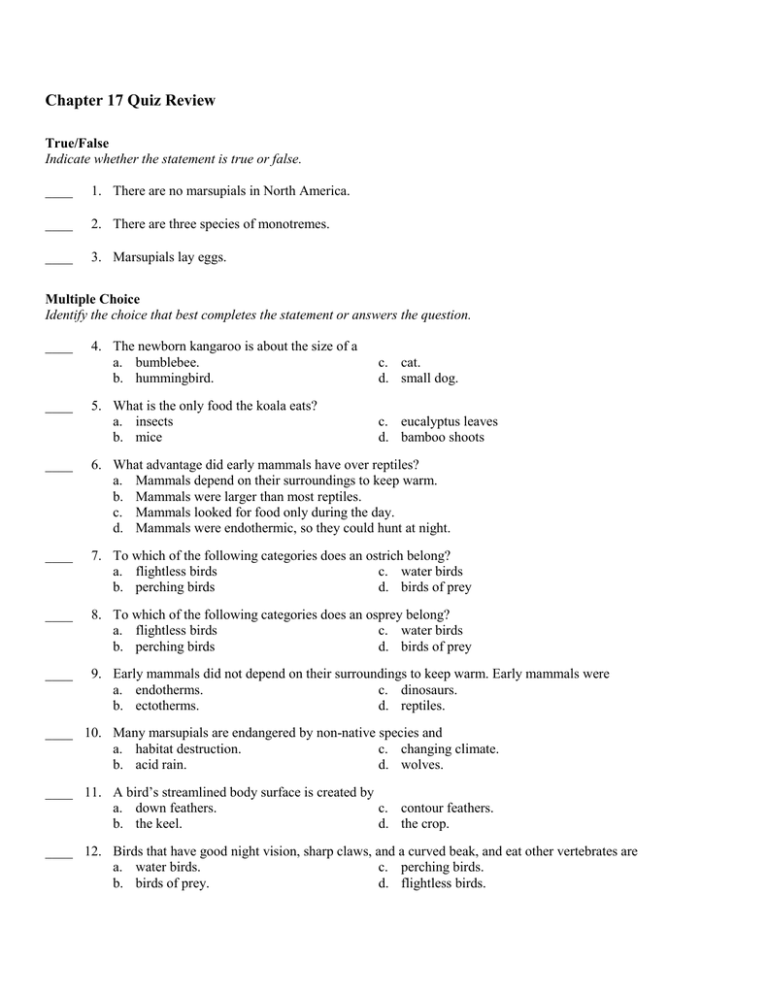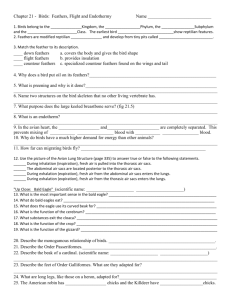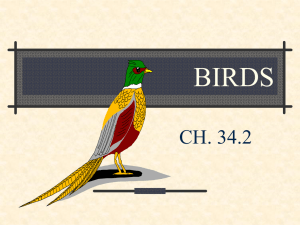Chapter 17 Quiz Review
advertisement

Chapter 17 Quiz Review True/False Indicate whether the statement is true or false. ____ 1. There are no marsupials in North America. ____ 2. There are three species of monotremes. ____ 3. Marsupials lay eggs. Multiple Choice Identify the choice that best completes the statement or answers the question. ____ ____ 4. The newborn kangaroo is about the size of a a. bumblebee. b. hummingbird. c. cat. d. small dog. 5. What is the only food the koala eats? a. insects b. mice c. eucalyptus leaves d. bamboo shoots ____ 6. What advantage did early mammals have over reptiles? a. Mammals depend on their surroundings to keep warm. b. Mammals were larger than most reptiles. c. Mammals looked for food only during the day. d. Mammals were endothermic, so they could hunt at night. ____ 7. To which of the following categories does an ostrich belong? a. flightless birds c. water birds b. perching birds d. birds of prey ____ 8. To which of the following categories does an osprey belong? a. flightless birds c. water birds b. perching birds d. birds of prey ____ 9. Early mammals did not depend on their surroundings to keep warm. Early mammals were a. endotherms. c. dinosaurs. b. ectotherms. d. reptiles. ____ 10. Many marsupials are endangered by non-native species and a. habitat destruction. c. changing climate. b. acid rain. d. wolves. ____ 11. A bird’s streamlined body surface is created by a. down feathers. c. contour feathers. b. the keel. d. the crop. ____ 12. Birds that have good night vision, sharp claws, and a curved beak, and eat other vertebrates are a. water birds. c. perching birds. b. birds of prey. d. flightless birds. ____ 13. What is the upward force on a flying bird’s wings? a. gravity c. wind b. pressure d. lift ____ 14. How do birds keep their eggs warm? a. by nesting b. by brooding c. by preening d. by hatching ____ 15. Which of the following is a water bird? a. robin b. kiwi c. blue-footed booby d. owl ____ 16. How do birds of prey use their curved beaks and sharp claws? a. to build strong nests c. to fight enemies b. to catch and eat food d. to grasp branches ____ 17. What is the only native North American marsupial? a. monotreme c. raccoon b. platypus d. opossum Completion Complete each statement. Use the terms from the following list to complete the sentences below. brooding preening precocial altricial placenta diaphragm endotherms therapsid mammary glands 18. The first mammals were ____________________, which allowed them to hunt by night and avoid dinosaurs by day. 19. Young birds that learn to feed themselves and walk shortly after hatching are called ____________________. Use the terms from the following list to complete the sentences below. preen molars molt incisors 20. When birds clean and oil their feathers, they ____________________. Use the terms from the following list to complete the sentences below. placenta uterus gestation period 21. In mammals, an embryo grows in the ____________________. 22. The time when the embryo develops inside the mother is called the ____________________. Matching Match each item with the correct statement. a. lift b. contour feathers c. precocial d. down feathers e. f. g. h. molting preening altricial brooding ____ 23. the process of shedding feathers, which are replaced by new feathers ____ 24. soft feathers that cover the body of young birds and insulate adult birds ____ 25. the act of grooming and maintaining feathers ____ 26. external feathers that help determine a bird’s shape ____ 27. an upward force on an object that moves in a fluid line ____ 28. to sit on and cover eggs to keep them warm until they hatch ____ 29. birds that are active shortly after hatching ____ 30. birds that are bald and helpless after hatching Match each item with the correct statement. a. perching bird b. songbird c. water bird d. flightless bird e. bird of prey ____ 31. Scientists have grouped all birds into 28 different orders. I am from the group that makes up the largest order. What am I? ____ 32. I have special adaptations for resting on branches. If I fall asleep on a branch, I will not fall off. I have short, sturdy feathers. What am I? ____ 33. I hunt and eat other vertebrates. I have sharp claws and a sharp, curved beak. I also have very good eyesight. What am I? Match each item with the correct statement. a. marsupial b. monotreme ____ 34. This mammal gives birth to live young early in their development. The young then grow in the mother’s pouch. Match each item with the correct statement. a. monotreme b. marsupial ____ 35. opossum ____ 36. koala ____ 37. wallaby Match each item with the correct statement. a. mammary glands h. down b. c. d. e. f. g. perching birds preening diaphragm monotreme molting gestation period i. j. k. l. m. lift marsupial brooding water birds contour ____ 38. the time between fertilization and birth, in mammals ____ 39. the category of birds that can grasp a tree branch ____ 40. the process of shedding feathers and growing new ones ____ 41. the upward pressure on wings ____ 42. the act of sitting on a nest to keep eggs warm Short Answer 43. What do an osprey, a kiwi, and a chickadee have in common? 44. How are birds and reptiles alike? 45. List the three main purposes of feathers. 46. Why do you think the gestation period for elephants (almost two years) is longer than that for dogs (about 2 months)? 47. When did the first mammals appear in the fossil record? 48. Explain why many marsupials are endangered or extinct. Essay 49. You find a baby bird in the schoolyard. Its eyes are closed, it has no feathers, and it is flopping around on the ground. How would you classify this chick? Explain your answer. Other CONCEPT MAPPING 50. Use the following terms to complete the concept map below: placental mammal egg marsupial uterus monotreme embryo Chapter 17 Quiz Review Answer Section TRUE/FALSE 1. F 2. T 3. F MULTIPLE CHOICE 4. 5. 6. 7. 8. 9. 10. 11. 12. 13. 14. 15. 16. 17. A C D A D A A C B D B C B D COMPLETION 18. 19. 20. 21. 22. endotherms precocial preen uterus gestation period MATCHING 23. 24. 25. 26. 27. 28. 29. 30. E D F B A H C G 31. B 32. A 33. E 34. A 35. B 36. B 37. B 38. 39. 40. 41. 42. G B F I K SHORT ANSWER 43. 44. 45. 46. They are all birds. They both have thick scales on legs and feet and lay eggs with shells and amniotic sacs. Feathers keep a bird dry, attract mates, and allow birds to fly. Sample answer: Larger animals take longer to develop. A baby elephant can weigh more than a person; a puppy can be as small as four ounces at birth. 47. more than 225 million years ago 48. Answers will vary. Sample answer: Europeans introduced non-native species such as rabbits that compete with marsupials for food and foxes that prey on marsupials. Habitat destruction has also been a factor in the decline of marsupial species. ESSAY 49. Answers will vary. Sample answer: This is an altricial bird. An altricial chick is born with eyes closed and cannot fly or care for itself. It has few feathers and is blind. OTHER 50. a. egg, b. marsupial, c. monotreme, d. uterus, e. embryo, f. placental mammal





